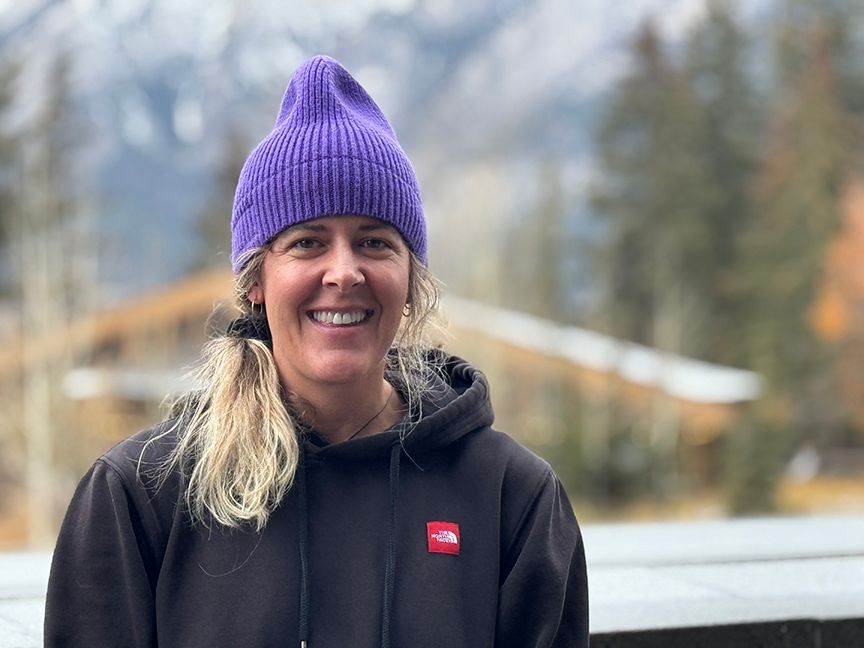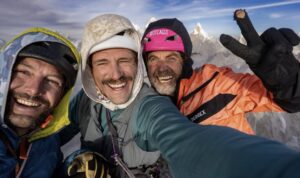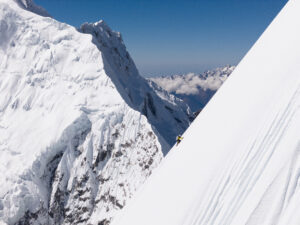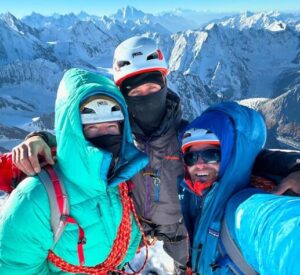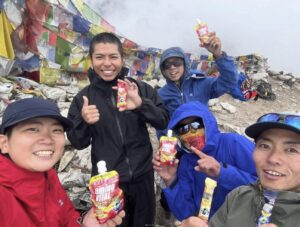Chantel Astorga is possibly the least suitable example of self-learning. Now a multifaceted alpinist with a strong leaning for solo climbing, Astorga learned the ABCs of climbing mainly from books. She studied knots, rope-soloing, and ice climbing. Soon, she was heading for Yosemite, Alaska, and the Himalaya.
Determined to stay away from the social media fanfare, Astorga is perhaps less well-known than others at her level, except in the U.S. community of elite alpinists and the organizing committees of Cutting Edge and Grit & Rock awards, where she is a regular recipient.
We had a chance to speak to her at the Banff Centre’s Mountain Film and Book Festival, where she took part in a panel on the future of alpinism.
A life-changing article
Chantel Astorga had no mountaineering background or interest in the mountains — except for snowboarding like many other teenagers — until she stumbled upon a magazine with an article called The Art of Suffering, the alpine manifesto of Voytek Kurtyka. One of the legendary Polish climbers who shaped winter 8,000m climbing during the 1980s, Kurtyka’s intense character stuck in the young woman’s mind.
“I really knew nothing about that stuff, but for some reason, it really drew me in, so I stole the magazine from the library, and…it set the course for my future.”
When Bernadette McDonald published The Art of Freedom, about Kurtyka’s climbs and thoughts, Astorga, then at university, devoured it. She had just one question: How do I become a climber?
Self-taught
“I decided to get a job as a ski patroller, so I switched from snowboarding to skiing,” she said. “I also realized that skiing was just a more efficient tool than split boards for moving in the mountains.”
She read more books about how to climb, then went out by herself and started. It sounds like the sort of experiment requiring a disclaimer like, “Kids, don’t try this at home.” But it worked out well for her.
There was this very moderate ice climb in Little Cottonwood Canyon, [Utah]. I would go down there every day after work and practice swinging the tools and kicking the crampons in. Then I bought a book about how to rope solo, and then I basically taught myself how to rope solo so I could ice climb this thing. That took a bit of time because the first time, I got scared and bailed. But eventually, I just was climbing this moderate ice with a rope by myself.
“I just felt natural, like I belonged there, I was so drawn to it,” she recalls.
She also did a lot of backcountry skiing, mostly on her own.
“My foundation was just like moving through the mountains on skis, and a lot of this I was just doing by myself and figuring it out,” she said.
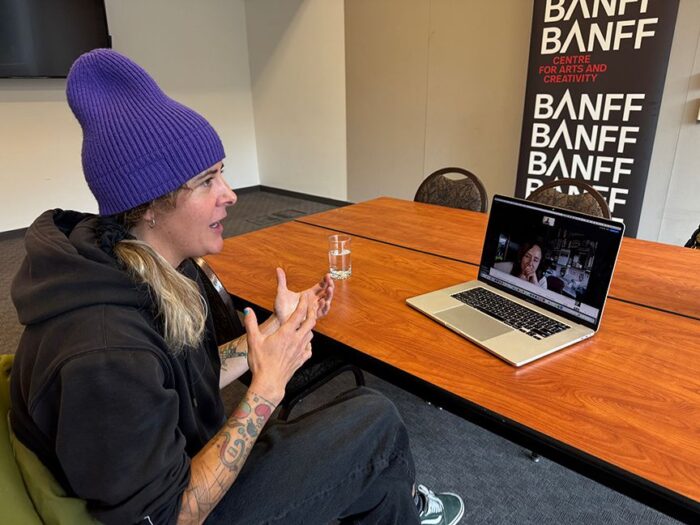
Chantel Astorga speaks to Angela Benavides in the Banff Film Festival’s press room. Photo: Jerry Kobalenko
Teenager on Denali
At the time, she met Willie and Damian Benegas. The brothers and Everest guides took Astorga under their wing. They gave her some of their hand-me-down gear, since she couldn’t afford to buy much equipment. They also took her on her first real rock-climbing experience: the Super Crack in Indian Creek.
The Benegas also lent her a pair of ski boots three sizes too big for her and smaller skis with Dynafit bindings. She then skied down Denali with them.
“I stuffed the toe box so that my foot would fit in there,” she casually explained.
Soon afterward, she was guiding groups up the normal route of the mountain.
By the time she considered herself an (intermediate) rock climber, she made a big move — to Yosemite Valley, no less.
Yosemite rookie
“I had a friend who was working on the search-and-rescue team in the Valley, so I spent the summer there, getting better and more familiar with granite and bigger walls,” she said. “I didn’t climb El Cap or anything that year, but then, yeah, somehow the next year, I ended up on the search-and-rescue team.”

File image of a young Chantel Astorga climbing El Cap. Photo: Chantel Astorga/Instagram
“It was super intimidating for me, because I just didn’t really feel good enough, or like I belonged there, and free climbing obviously takes time to progress. I just kind of focused on what was my strength at that time, which was big wall climbing. [Then] I just got into the speed-climbing scene, and so I started doing a lot of that, and then soloing walls and stuff…”
The “stuff” is female speed records on The Nose, Lurking Fear, and Zodiac between 2010 and 2014, a solo climb of El Cap’s The Nose in 2014, and the first linkup of The Nose of El Capitan with the NW Regular Route of Half Dome on a female team. Not bad for someone who, not many years earlier, had been a beginner.
Avalanche forecaster to pro
Next came some impressive climbs in Alaska, like the first free ascent of Mount Huntington’s Polarchrome route in a day (Grade V, WI6, M7), and her first expeditions to the Himalaya. Yet, like most alpinists, she needed to keep a day job to keep going. In her case, she became an avalanche forecaster, a not-so-well-paid job but something she enjoyed. It gave her flexibility and enough of an off-season to plan for an expedition every two years (all she could afford). When the budget didn’t fit, there was always Alaska.
In 2021, Astorga stunned the climbing community by soloing Denali’s Cassin Ridge.
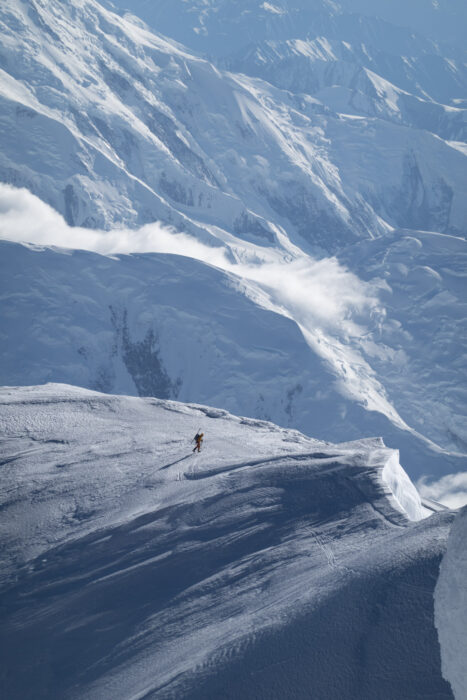
Chantel Astorga soloing the huge Cassin ridge on Denali. Photo: Zach Novak
Around the time of COVID, she was invited to join The North Face team. Asked if she feels pressured by her new responsibilities to a major sponsor, she said no. She feels she is able to climb what she wants, with whom she wants, and that the real pressure comes from herself.
“I feel that, because I’m a sponsored athlete, I should be performing at the highest level at all disciplines,” she admitted.
What she fears most about her new role as a professional climber is social media.
“I never had social media before I signed the agreement, and I was happy like that. Now I have to work on it, which I understand I must, but I can’t say I like it.”
The Sivling lesson
As with every climber, elite or no, her climbs are not always successful, and Astorga has also learned to deal with that frustration and to redirect any feelings of disappointment toward the positive. That’s what happened last year on Shivling (6,543m) in India’s Garhwal Himalaya. Astorga and Fanny Schmutz of France were granted one of the American Alpine Club’s Cutting Edge grants for a second attempt of the peak’s Direct East Face.
“Fanny and I got awfully close to finishing it, but we just couldn’t find anywhere to sleep, no bivy spots, so we got super depleted, beyond exhausted, so after six days, we ended up deciding to bail,” she explained. “It was the right thing to do, but it was really hard. When we both got down, we were so tired and so cold that I couldn’t regulate my body temperature for three months.”
It taught her how the mind can push a driven climber to continue, but the body has a limit to what it can endure.

No rest allowed on the Direct East Face of Shivling, India. Photo: Fanny Schmutz
Only so much juice
“Each person has only so much stoke juice in them, and when you get to the bottom, you’ve got to recover, yeah, to build up the reservoir again, to get back a really strong foundation,” she said.
In 2024, Chantel Astorga participated in two Himalayan expeditions, including skiing the Great Trango Tower with Jim Morrison and Christina Lustenberger, and Shivling. This year, she just “stayed home” on U.S. rock routes and in Alaska.
I did go to the Alaska Range, but we made it a very fun trip where we tried to climb a new route on a smaller peak and then paraglide off. We then paddled packrafts back to civilization, and that was just pure joy rather than the suffering that often comes with alpine climbing. Now, I feel the excitement again and am dreaming big.
Astorga and Schmutz will return to Shivling in 2026, a mountain that, for Astorga, epitomizes the perfect challenge in its hardship and beauty. This time, they’ll use inflatable portaledges to solve the problem of being able to rest on its vertical walls, similar to those the American team used on the North Face of Jannu in 2023.
Climbing with women
Astorga has led many expeditions with other women climbers. Is that just a coincidence, or does she prefer women as climbing partners? Here is what she said about it:
There’s just not that many women whose goals are opening new technical lines in the bigger mountains or climbing the harder routes. Ten years ago, there were even a lot less, so it was just natural to keep connecting with those who have the same motivations that I align with and who happen to be female. So it might not be luck, but it’s been pretty cool that it’s played out that way without actually forcing it.
The future: fly down
Since Astorga came to the Banff Festival to participate in a panel about the future of alpinism, we asked about that.
For Astorga, recent gear innovations have expanded the possibilities for expeditions. She mentioned better skis and boots, the inflatable portaledge she will use on Shivling, and one of her favorites: ultra-light paragliders, which weigh barely a kilo and allow a different type of descent.
“Climbing with skis and ski boots is the number one way to make the descent more fun,” she says. “But now you have the ability to carry these small paragliders that you hardly notice while climbing, and which allow you to avoid the descent altogether.”

Astorga approaches Trango Tower, Pakistan, in less-than-ideal skiing conditions. Photo: Sav Cummins
“I have fluctuated in my opinion about which is more dangerous: paragliding or just descending on foot. This year, I’ve come to think strongly that paragliding can be a much safer descent tool if you’re well-versed in it and you have a lot of flights under your belt.”
The paragliding option is especially appealing for a solo climber like Astorga.
“It’s like, I’ve dreamed of doing things, but I’m afraid of descending a particular mountain or ridge by myself because of crevasse exposure…[But if] I go in the right weather window where I can paraglide off the top, I can skip the descent! It’s so beautiful to combine these things!”
